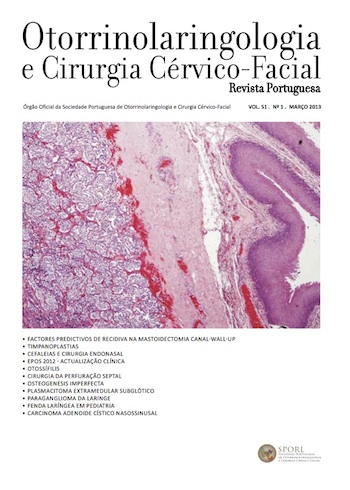Nasal mucocutaneous leishmaniasis – An unusual form of presentation
DOI:
https://doi.org/10.34631/sporl.1084Keywords:
leishmaniasis, mucocutaneous leishmaniasis, nasal leishmaniasisAbstract
Leishmaniasis is caused by the protozoan parasite Leishmania which is transmitted through bites of infected female phlebotomine sandflies. There are 3 main forms – visceral, cutaneous and mucocutaneous, with mucosal affection being the rarest manifestation of the disease. The incidence in Portugal is considered hypoendemic.
We present a case of a 48 years old female, with complaints of nasal obstruction, epistaxis and irregular erythematous scaly plaques surrounding the nostrils. Histology of the nasal septum and skin revealed the presence of Leishmania-Donovan bodies. She was treated with amphotericin-B and itraconazole with clinical improvement and disappearance of lesions.
Mucocutaneous leishmaniasis preferably affects the nasal mucosa and if not diagnosed and treated in time can lead to cartilage destruction and dissemination of mucosal lesions to the nasopharynx, larynx, compromising the airway and even leading to disfigurement.
Downloads
References
Neto FX, Rodrigues AC, Silva LL, Palheta AC, Silva FA. Manifestações otorrinolaringológicas relacionadas à leishmanisoe tegumentar americana: revisão de literatura. Arq. Int. Otorrinolaringol. [Internet] 2008; 12(4): 531-537. Disponível em: http://www.arquivosdeorl.org.br/conteudo/pdfForl/568.pdf.
Campino L, Maia C. Epidemiologia das leishmanioses em Portugal. Acta Med Port 2010; 23(5): 859-864.
Handler MZ, Patel PA, Kapila R, Al-Qubati Y, Schwartz RA. Cutaneous and mucocutaneous leishmaniasis: Clinical perspectives. J Am Acad Dermatol. 2015 Dec;73(6):897-908; quiz 909-10. doi: 10.1016/j.jaad.2014.08.051.
World Health Organization. Leishmaniasis key facts. [Internet] [Accessed 2022 May 3] Geneva: WHO; 2022. Disponível em: https://www.who.int/news-room/fact-sheets/detail/leishmaniasis.
Maia C, Campino L. Leishmaniose em Portugal no início do século XXI. Anais IHMT, Saúde Global e Doenças Tropicais. 2014; 3: 25-29. doi: 10.25761/anaisihmt.167.
Marra F, Chiappetta MC, Vincenti V. Ear, nose and throat manifestations of mucocutaneous Leishmaniasis: a literature review. Acta Biomed. 2014 May 9;85(1):3-7.
Hsu DW, Suh JD. Anatomy and physiology of nasal obstruction. Otolaryngol Clin North Am. 2018 Oct;51(5):853-865. doi: 10.1016/j.otc.2018.05.001.
Lessa MM, Lessa HA, Castro TW, Oliveira A, Scherifer A, Machado P. et al. Leishmaniose mucosa: aspectos clínicos e epidemiológicos. Rev. Bras. Otorrinolaringol. 2007: 73(6): 843-847. doi: 10.1590/S0034-72992007000600016.
Cipriano P, Miranda AC, Antunes I, Mansinho K. Leishmaniose visceral em doentes com infeção VIH: o desafio da recaída e falência terapêutica. Acta Med Port. 2017 Jun 30;30(6):443-448. doi: 10.20344/amp.8291.
Diniz JL, Costa MO, Gonçalves DU. Mucocutaneous leishmaniasis: clinical markers in presumptive diagnosis. Braz J Otorhinolaryngol. 2011 Jun;77(3):380-4. doi: 10.1590/s1808-86942011000300018.
Casalle N, de Barros Pinto Grifoni L, Bosco Mendes AC, Delort S, Massucato EMS. Mucocutaneous leishmaniasis with rare manifestation in the nasal mucosa and cartilage bone septal. Case Rep Infect Dis. 2020 Sep 22;2020:8876020. doi: 10.1155/2020/8876020
Manual de Controle da Leishmaniose Tegumentar Americana. 5th rev. ed. [Internet] Brasilia: Ministério da Saúde. Fundação Nacional de Saúde; 2000; 62 p. Disponível em:https://bvsms.saude.gov.br/bvs/publicacoes/funasa/manu_leishman.pdf.
Aronson N, Herwaldt BL, Libman M, Pearson R, Lopez-Velez R, Weina P. et al. Diagnosis and treatment of Leishmaniasis: clinical practice Guidelines by the Infectious Diseases Society of America (IDSA) and the American Society of Tropical Medicine and Hygiene (ASTMH). Clin Infect Dis. 2016 Dec 15;63(12):1539-1557. doi: 10.1093/cid/ciw742.
Rojas-Jaimes J, Frischtak HL, Arenas J, Lescano AG. Case report: mucosal leishmaniasis presenting with nasal septum perforation after almost thirty years. Am J Trop Med Hyg. 2018 Aug;99(2):327-330. doi: 10.4269/ajtmh.17-0831.
Downloads
Published
How to Cite
Issue
Section
License
Copyright (c) 2023 The authors retain copyright of this article.

This work is licensed under a Creative Commons Attribution-ShareAlike 4.0 International License.






